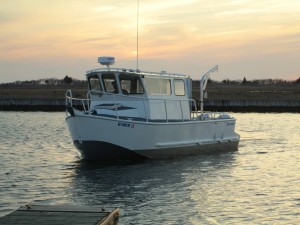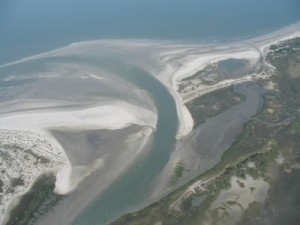 Coastal Science & Engineering (CSE) specializes in engineering, planning, and scientific studies in the coastal zone. For over 35 years, our specialists in the fields of coastal and environmental engineering, geology, and oceanography have developed innovative solutions to problems related to coastal development, marina and port facilities, point- and nonpoint-source discharges, and natural hazards along the coast. This work has taken us to the Middle East, Alaska, the Caribbean, and New England, as well as our home territory in the southeastern United States. Highlights of our work include:
Coastal Science & Engineering (CSE) specializes in engineering, planning, and scientific studies in the coastal zone. For over 35 years, our specialists in the fields of coastal and environmental engineering, geology, and oceanography have developed innovative solutions to problems related to coastal development, marina and port facilities, point- and nonpoint-source discharges, and natural hazards along the coast. This work has taken us to the Middle East, Alaska, the Caribbean, and New England, as well as our home territory in the southeastern United States. Highlights of our work include:
- Planning, design, and construction management of over 50 beach nourishment projects involving more than 40 million cubic yards.
- Project engineering for Nags Head NC – Largest locally funded nourishment project to date in the United States – 4.6 million cy over 10 miles of beach.
- Formulation of methodology for objective placement of coastal setback lines which was adopted into law in South Carolina.
- Project direction for the multiyear development of a computer model to simulate the movement of oil spills at the coastline.
- Service as special advisor to the South Carolina Governor’s Office in the wake of Hurricane Hugo which included formulation of a $10 million emergency beach and dune restoration plan.
- Completion of water-quality, circulation, and flushing studies for over 20 marina, harbor, estuarine, and tidal inlet sites along the US East Coast and in the Middle East.
This work has required extensive field-data collection and state-of-the-art analytical techniques involving computer simulation modeling and management of large data bases. CSE’s archives include detailed shoreline maps, tidal data, water-quality data, and erosion surveys for over 100 localities, giving us broad site-specific experience. The diversity of the Carolina coast, our home territory, often allows us to draw on site-specific experience in developing solutions to coastal problems in other geographic areas.
 CSE’s multidisciplinary approach to coastal engineering is well adapted to complex environmental problems involving air/sea/land interactions. In one project, for example, CSE developed a wetlands enhancement plan for a poorly flushed canal system in a southeastern salt marsh. The plan required development of a hydrodynamic model to simulate existing conditions and alternative improvements. CSE scientists studied the distribution of plant communities as a function of topography and tidal flushing to develop plans for habitat creation. Geologists and coastal engineers at CSE evaluated sediment transport and shoaling to design improvements which would be self-maintaining or which would require low maintenance. Among the factors considered in the plan were potential impacts of global sea-level rise, a factor which CSE scientists have studied under EPA sponsorship since 1984. A basic philosophy of this project was to design with nature and preserve the character of the setting as much as possible.
CSE’s multidisciplinary approach to coastal engineering is well adapted to complex environmental problems involving air/sea/land interactions. In one project, for example, CSE developed a wetlands enhancement plan for a poorly flushed canal system in a southeastern salt marsh. The plan required development of a hydrodynamic model to simulate existing conditions and alternative improvements. CSE scientists studied the distribution of plant communities as a function of topography and tidal flushing to develop plans for habitat creation. Geologists and coastal engineers at CSE evaluated sediment transport and shoaling to design improvements which would be self-maintaining or which would require low maintenance. Among the factors considered in the plan were potential impacts of global sea-level rise, a factor which CSE scientists have studied under EPA sponsorship since 1984. A basic philosophy of this project was to design with nature and preserve the character of the setting as much as possible.
CSE offers a high level of expertise and experience tailoring projects to fit the needs of clients. We pride ourselves on innovation, responsiveness, and the development of sensible solutions for environmental problems. For more detailed information about a particular area of our qualifications, please see the list below, or the appropriate category under our Services page.
SERVICES AND ENGINEERING CAPABILITIES
REGULATORY & ENVIRONMENTAL
- Public agency approvals and coordination
- Environmental assessments and impact statements
- Coastal Area Management Act permitting
- Erosion and sediment control design and permitting
- Stream bank erosion assessment and restoration
- No rise flood studies (County and City)
- Review of federal flood studies
COASTAL ENGINEERING
- Beach nourishment design
- Shoreline erosion assessments
- Evaluation of shoreline, dune and wetland mitigation opportunities
- Innovative shoreline erosion solutions
- Tidal inlet sedimentation, relocation and hydraulic studies
- Wind and wave studies
- Wave diffraction and refraction studies
- Shore protection structures
- Water quality assessments and basin flushing studies
- Flushing studies/modeling
- Wave loads on structures
- Groins, jetties and breakwater design
- Soft erosion control solutions inlet-shoal management
- Inlet relocation/realignment
- Accreted land management
- Beach management – dune fencing and vegetation
- Historical shoreline analysis, setback line revisions
SMALL CRAFT HARBORS AND MARINAS
- Marina master planning
- Floating breakwaters
- Marina feasibility studies and site evaluations
- Sedimentation and scour studies
- Hydrodynamics and water quality modeling
- Regional circulation and flushing studies
DREDGING & DREDGED MATERIAL DISPOSAL
- Formulation of long term dredging and disposal plans
- 3D modeling of dredge channel design
- Physical analyses of dredged material
- Dredge and fill permitting
- Confined disposal area and hydraulic structures
- Disposal alternative studies
COASTAL FIELD DATA COLLECTION & PROCESSING
- In situ wave, tides and current measurement and analysis
- Sediment transport measurement and analysis
- Topographic and bathymetric data collection
- Beach compaction testing
- Sand searches, offshore and inshore
- Advanced sediment grain size analysis
- Bottom coring and analysis
- Measurement of water quality parameters
- Aquatic resource mapping and data base development
- Beach monitoring, profiling and analysis
- GIS database development
NUMERICAL MODELING & SIMULATION
- One Dimensional Hydraulic (Riverine) ModelsHEC-RAS (versions 3 & 4) CONCEPTS
- Circulation Models ADCIRC MSD
- Morphological Models GENESIS SBEACH
- Wave Models STWAVE CGWAVE
- Two Dimensional Hydrodynamic Models (Riverine) RIVER2D RMA2
- 2-D Hydraulic (Riverine) & Sediment Transport Models CCHE2D RMA4 SED2D
- Hydrologic Models
- HEC-HMS (Version 3)
- WINTR55
- EPA SWMM 5.0
- Hydrocad
- Hydrologic and Sediment Transport Models RUSLE 26
- Biological Treatment Process Simulation BIOWIN

